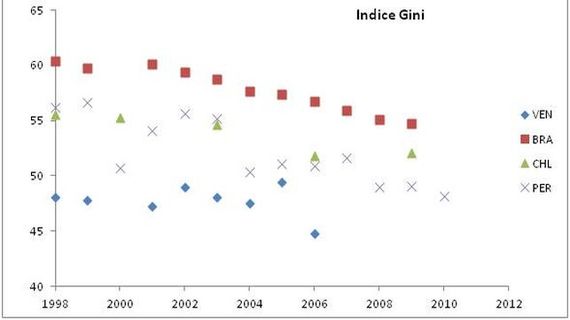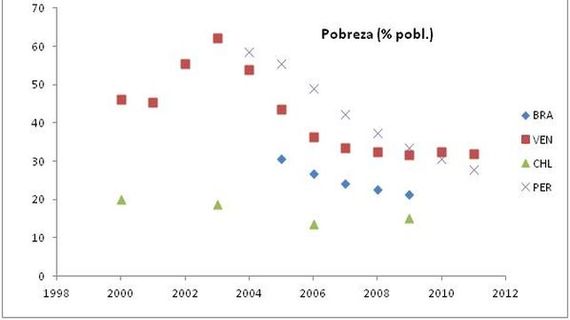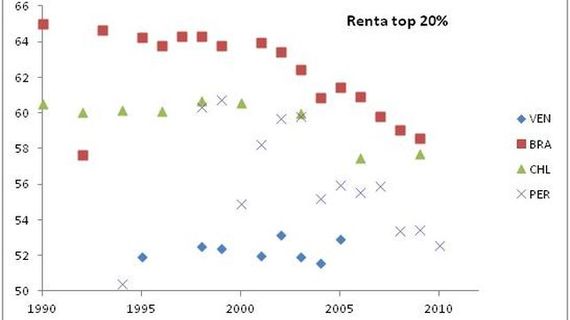Since the death of Venezuelan President Hugo Chavez some elements of the European and British left have praised his project, especially with regards to the fight against poverty and inequality. Some have even argued that Chavismo represents a viable economic alternative. Since Western economies are drowning in a sea of debt, unemployment and growing inequality, any available alternative can seem attractive to a demoralized and disoriented left. But, is this true? Should Chavez be seen as a reference for the left?
The best way to answer these questions is to evaluate Chavez' performance on the three defining axes for the left: reducing poverty, fighting inequality and consolidating freedom and democracy. The regimes limitations regarding democracy and freedom have already been highlighted elsewhere (see for instance Human Rights Watch). However less attention has been paid to analysing poverty and inequality in comparative terms. Did Venezuela perform better than Chile, Peru or Brazil in terms of reducing poverty and inequality? These are the results :
Venezuela achieved important reductions in poverty since Chavez came to power in 1998. His social projects known as "misiones" brought schools, hospitals and clean water to many who previously had nothing. According to the World Bank, the percentage living below the poverty line fell from 46.3% in 2000 to 31.9% in 2011.
However, as the graph above shows, poverty reduction was very pronounced in other places as well. In Peru, for instance, the proportion of people living below the poverty line fell from 58.7% in 2004 to 27.8% in 2011. That is a much steeper decline in a shorter period of time. The difference is that in Peru, poverty reduction was accompanied by structural and institutional improvements, while in Venezuela poverty reduction was financed with juicy petrodollars.
In the decade that followed Chavez' first election, oil prices went from 9$ a barrel to more than 100$. In the same period, revenues of the state oil monopoly, "Petróleos de Venezuela" (PDVSA), increased by a factor of five. This unprecedented bubble benefited the poor. But those benefits could disappear as quickly as they came.
What about inequality? The Gini Index suggests improvements in the four selected countries (see graph above). But Venezuela did no better than its peers when it came to reducing inequality either. Digging a bit deeper, it is easy to see why. The data tells us that unlike in the other selected countries, the percentage of income accruing to the richest 20% increased. This is not particularly good news for a country that prides itself on having invented XXI century socialism.
This figure won't surprise Venezuelan readers. The new Venezuelan oligarchy is so well known in Venezuela that they even have a name: "los boliburgueses". They are the corrupt winners of the bubble, the allies of the regime's authorities and their friends who are the true beneficiaries of the massive capture of oil rents in Venezuela.The management of the oil boom in Venezuela reminds me of the construction bubble in Spain. Spain, like Venezuela, received massive "extra" income from the construction bubble which allowed the country to create jobs and reduce public debt. In fact, members of the Zapatero government still argue today that fiscal policy was good as Spain's debt to GDP was lower than 40% when the crisis started. Are they right?
Not really. The government in Spain used the bubble to delay necessary reforms, invested in unsustainable projects and saved too little. Very much like poverty reduction in Venezuela, the employment created in Spain was a mirage. When the bubble burst, unemployment (and poverty) boomed and the Spanish government couldn't keep its commitments. The same is already happening in Venezuela.
Does this mean that all bubbles are bad? Not necessarily. In Chile for instance copper prices quadrupled but instead of squandering the fruits of the commodity boom, the government accumulated a reserve fund amounting to 15% of GDP. That decision cost Andrés Velasco, the then socialist Finance Minister, a huge loss of popularity. But it was worth it. When the crisis hit and copper prices plummeted, Chile was able to put forward the largest stimulus plan in the world, some 2.8% of GDP.
In 2008, after the collapse of the global economy, oil prices dropped and the first signs of weakness began to appear in Venezuela. Now, the economy is on the brink of collapse with debt growing at breakneck speed and an inflation of over 30%. And who is that inflation hurting the most? Savers, those living on fixed incomes (retirees, pensioners) and those with no assets or bank debt. In other words: the poor.
These results do not support Chavez's supposed leftist credentials. It would be much better for the European and British left to look at more sensible Latin American leftist leaders such as Velasco or Lula, and less toward Chávez's siren calls.



